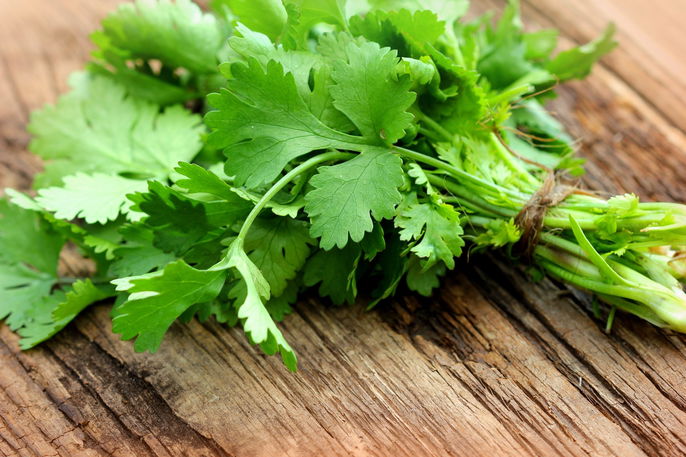Cilantro is an aromatic plant rich that is in phenolic compounds like carotenoids, tannins, flavonoids and saponins. As a result, cilantro can offer several health benefits and can help to manage cholesterol and blood glucose levels, and prevent diseases such as heart attacks and diabetes. In addition, cilantro has high levels of potassium, which promotes the elimination of sodium through the urine to keep blood pressure within normal levels.
Because it is high in vitamin C and vitamin A, cilantro also helps to fight free radicals, which can boost immunity, prevent premature aging and keep the skin hydrated and firm.
Cilantro leaves and seeds can be purchased at grocery stores and farmer's markets, and are used to season salads, pasta, stews, juices, teas and curry.

Coriander vs cilantro
The difference between coriander and cilantro is the part of the plant Coriandrum sativum plant utilized. Coriander refers to the seeds of Coriandrum sativum, which are ground into a powder and used for seasoning. Cilantro refers to the stems and leaves of the plant, which are used dried or fresh as an aromatic herb.
Health benefits
The main health benefits of cilantro include:
1. Preventing some types of cancer
Cilantro is rich in carotenoids, tannins and flavonoids, which are compounds with potent antioxidant power. It can block the action of free radicals in the body, and can prevent some types of cancer such as breast cancer, lung cancer and prostate cancer.
2. Maintaining healthy skin
Cilantro is rich in antioxidants that reduce the damage that the sun's ultraviolet rays can cause, and therefore it can be consumed to prevent premature aging, reduce wrinkles and decrease sagging. In addition, by protecting cells against free radicals, cilantro can play a role in preventing skin cancer.
3. Lowering cholesterol and triglycerides
Because it contains healthy fats, such as oleic, palmitic and stearic fatty acids, as well as antioxidants like vitamin C, cilantro can help reduce levels of LDL cholesterol and triglycerides in the blood. This can prevent the formation of fatty plaques along the walls of the blood vessels.
In addition, cilantro helps to increase HDL cholesterol which protects the body from diseases such as heart attacks, strokes and atherosclerosis.
4. Improving digestion
Cilantro has a powerful anti-inflammatory and hepatoprotective action, which protects and boosts liver function. This can help to optimize food digestion and nutrient absorption.
5. Controlling high blood pressure
Cilantro is rich in potassium, a mineral that is important for the elimination of excess sodium through urine. This mechanism is beneficial for controlling high blood pressure. In addition, cilantro is rich in calcium, which helps to relax the arteries and promote blood circulation.
6. Preventing diabetes
Because it contains antioxidant properties, cilantro can strengthen pancreatic functioning and optimize the way insulin works to manage blood sugar levels.
Some studies [1,2] have shown that consuming cilantro can keep blood sugar levels within normal levels, preventing insulin resistance and diabetes.
7. Helping to detox the liver
Cilantro has a powerful antioxidant effect that helps to detox the liver, as it promotes the elimination of toxins and toxic metals, such as mercury, from the body. Read more about a liver detox diet and which foods to consume for liver health.
8. Promoting gut health
Cilantro essential oil contains antimicrobial properties that combat harmful bacteria in the gut and help to balance the intestinal flora. Therefore it can be consume to prevent infections, treat diarrhea and reduce constipation, as it stimulates preventing infections and diarrhea. In addition, cilantro also helps combat constipation, as the plant stimulates natural bowel movements.
Nutritional information
The following table outlines the nutritional information for 100 g of cilantro:
Cilantro can be consumed fresh or dried, and can be added to flavor salads and teas.
How to use
Cilantro is commonly used as a fresh or dried herb to season meat, fish, salads or juices. Its leaves can also be used in the form of tea.
The seeds can be used fresh or ground into coriander to be used in teas, salads and as a base for curry seasoning. The seeds are also used in to make essential oil.
- Cilantro seed or leaf tea: Cilantro tea can be prepared by adding 1 tablespoon of the seeds to 500 ml of boiling water and boiling for an additional 2 minutes. Then remove from heat and allow the mixture to infuse for another 10 minutes. Strain and serve while warm. Another option is to add 1 tablespoon of cilantro leaves to 250 ml of boiling water. Then allow to infuse for 5 to 10 minutes and strain. This leaf tea can be consumed warm or cold.
- Cilantro essential oil: cilantro essential oil can be purchased in natural health stores and some drugstores and is obtained from the seeds of the plant. It is used in the food industry to prevent food contamination and to flavor meats and canned foods. In addition, in recent years, research has been conducted into the possibility of using cilantro essential oil to combat infections such as dermatitis and candidiasis.
Healthy cilantro recipes
Check-out some tasty recipes you can prepare enjoy all the benefits of cilantro:
1. Cilantro sauce
Ingredients:
- 1 cup of coarsely chopped cilantro
- 1 clove of garlic
- 2 tablespoons of lemon juice
- 2 tablespoons of olive oil
- 1 level teaspoon of salt
- ½ cup of water
- ¼ cup of cashews
How to prepare:
Blend all the ingredients in a blender until a uniform paste is formed. This sauce can be used to accompany salads, red meats or barbecues.
2. Onion and cilantro omelet
Ingredients:
- 6 eggs
- 2 tablespoons of chopped fresh cilantro
- 1 chopped onion
- 1 chopped garlic clove
- 1 tablespoon of olive oil
- Black pepper and salt to taste
How to prepare:
Place the eggs in a bowl and stir well with a fork until the whites are well mixed with the yolks. Add the remaining ingredients and stir carefully. Heat a non-stick frying pan and add the olive oil. Add half of the omelet and cook for 2 to 3 minutes on each side or until golden brown. Repeat the procedure with the other half of the omelet. Wait for it to cool and serve with your favorite side dishes.
3. Tilapia ceviche

Ingredients:
- 6 tilapia fillets
- 1 medium red onion
- 1 chili pepper
- Cilantro to taste
- 2 Tahiti limes
- Salt to taste
- Black pepper to taste
How to prepare:
Slice the onions thinly and place in ice water for 10 minutes. Drain well and set aside. Remove the seeds from the pepper, and chop finely and set aside. Wash the cilantro leaves, chop and set aside. Place ice cubes in a large bowl, placing another smaller bowl on top. Cut the fish fillet into cubes and place in the smaller bowl on top of the ice. Add the chopped onion, pepper and cilantro to the fish and season with the lime, salt and black pepper. Refrigerate for a few minutes and serve.
4. Guacamole
Ingredients:
- 4 avocados;
- 1 large seedless tomato
- 1 medium onion
- 2 minced garlic cloves
- 1 bunch of cilantro;
- Juice of 1 large lemon;
- 1 tablespoon of extra virgin olive oil;
- 1 ½ teaspoons of salt.
How to prepare:
Roughly mash the avocado with a fork, leaving some pieces for texture. Add the chopped garlic, lemon juice, salt and olive oil and mix well. Chop the onion, tomato and cilantro and add to the avocado mixture, mixing well. Serve with tortillas, nachos or as a side dish with rice and beans.






























